
Although, this blog is about my Aradhya, Shiva, I cannot just distinguish Him from Shakti. Well, that is not the only reason, the other reason for doing this is a bit personal.
I am a Bengali to the core and when the whole of Bengal is echoing with "dhaker badyo", I cannot just sit here and do nothing about it.
Well, tomorrow happens to be MahaSaptami, a word that brings so many happy memories in my mind. On this ocassion, I present you a short story on Maa Mahisasur Mardini, Maa Durga.
Jai Durga
Jai Bangali
(Image from here)
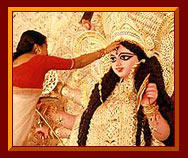
About Goddess Durga
Durga Puja
Capture the hearts and minds of her ecstatic devotees.
Durga, in Sanskrit means "She who is incomprehensible or difficult to reach." Goddess Durga is a form of Sakti worshiped for her gracious as well as terrifying aspect. Mother of the Universe, she represents the infinite power of the universe and is a symbol of a female dynamism. The manifestation of Goddess Durga is said to emerge from Her formless essence and the two are inseparable.
She is also called by many other names, such as Parvati, Ambika, and Kali. In the form of Parvati, She is known as the divine spouse of Lord Shiva and is the mother of Her two sons, Ganesha and Karttikeya, and daughter Jyoti. Destroyer of demons, she is worshiped during an annual festival called Durga puja, especially popular among Bengalis.

Her Appearance
There are endless aspects of Durga described in the Puranas and Agamas and the iconography is consequently very varied. She is usually pictured as having ten arms holding Sword, Conch, Discus, Rosary, Bell, Winecup, Shielf, Bow, Arrow, and Spear. She is most often shown riding a lion from which comes Her august name, Simhavahini, "She who stands astride the king of beasts". She is gorgeously dressed in royal red cloth and has several ornaments decorating Her personage. Her hair is dressed up in a crown (karandamukuta) which then flows out in long luxuriant tresses that are darkly luminous and soothing to the eye. The various tools reflects the eminent supremacy that helps in controling the universe and obey Her will.
Weilding Energy
Goddess Durga exists eternally, always abiding in her own sweet nature and inhabits the hearts and minds of her ecstatic devotees. As Shakti power, she shapes, nurtures, and dissolves names and forms, while as subtle spiritual energy called Kundalini, She lights the lotuses fo the seven centres of awareness in the sacred human body. Goddess Durga killed the powerful demon Mahish and all his great commanders. When demonic forces create imbalance all god unite becoming one divine force called Shakti or Durga.
The Bengalee Belief
Durga Puja
The beautiful Bengali decoration surrounding the majestic warrior.
Sati, the consort of Shiva was the daughter of Daksha Prajaapati a descendant of Bhrama. Sati had married Shiva against the wishes of her father. Daksha was sponsoring a sacrifice and attendees came from various parts of the universe. He invited all of the gods and goddesses except his son in law Shiva. Against Shiva's wishes, Sati attended this sacrifice and was insulted by her father. Unable to bear this insult, Sati immolated herself.
Enraged at the insult and the injury, Shiva destroyed Daksha's sacrifice, cut off Daksha's head and when pleaded by other gods, replaced it with that of a goat and restored him to life. Still berserk with grief, he picked up the remains of Sati's body, and danced the dance of destruction throughout the Universe. The other gods intervened to stop this dance, and the disk of Vishnu cut through the corpse of Sati, whose various parts of the body fell at several spots all through the Indian subcontinent and formed the sites of what are known as Shakti Peethas today.
Shiva was finally pacified when the last piece fell off from his shoulder. Narayana revived sati as Uma for a new life. Ever since peace was restored, Uma, with her children, Ganesh and Kartick, and with her two 'sakhis' - Jaya and Bijaya, comes to visit her parent's home each year during the season of 'Sharat' or autumn when Durga Puja is celebrated.
Regional Names of Durga Puja
Durga Puja
Goddess, invoked for protection from the powers of evil.
Durga Puja is identified by different regional names throughout India. This diversity across various states bind the people in a unique way. Durga Puja is one of the most important religious festival of Hindus, celebrating the return of the goddess to her natal home. But, this great Hindu festival is recounted and celebrated slightly differently in various regions taking on different forms and names. The festival of Durga Puja is characterized by a variety of prayers and rituals. The name of the Durga puja vary from locale to locale as common for most of the Hindu festivals. The various distinct regional names of this festival are:
* Durga Puja / Durga Pujo
* Navratri Puja
* Kullu Dussehra
* Mysore Dussehra
* Bommai Kolu
* Ayudha Puja
* Vidyaramba
* Saraswati Puja
* Simollanghan
Durga Puja / Durga Pujo

About Goddess Durga
Durga Puja
Capture the hearts and minds of her ecstatic devotees.
Durga, in Sanskrit means "She who is incomprehensible or difficult to reach." Goddess Durga is a form of Sakti worshiped for her gracious as well as terrifying aspect. Mother of the Universe, she represents the infinite power of the universe and is a symbol of a female dynamism. The manifestation of Goddess Durga is said to emerge from Her formless essence and the two are inseparable.
She is also called by many other names, such as Parvati, Ambika, and Kali. In the form of Parvati, She is known as the divine spouse of Lord Shiva and is the mother of Her two sons, Ganesha and Karttikeya, and daughter Jyoti. Destroyer of demons, she is worshiped during an annual festival called Durga puja, especially popular among Bengalis.

Her Appearance
There are endless aspects of Durga described in the Puranas and Agamas and the iconography is consequently very varied. She is usually pictured as having ten arms holding Sword, Conch, Discus, Rosary, Bell, Winecup, Shielf, Bow, Arrow, and Spear. She is most often shown riding a lion from which comes Her august name, Simhavahini, "She who stands astride the king of beasts". She is gorgeously dressed in royal red cloth and has several ornaments decorating Her personage. Her hair is dressed up in a crown (karandamukuta) which then flows out in long luxuriant tresses that are darkly luminous and soothing to the eye. The various tools reflects the eminent supremacy that helps in controling the universe and obey Her will.
Weilding Energy
Goddess Durga exists eternally, always abiding in her own sweet nature and inhabits the hearts and minds of her ecstatic devotees. As Shakti power, she shapes, nurtures, and dissolves names and forms, while as subtle spiritual energy called Kundalini, She lights the lotuses fo the seven centres of awareness in the sacred human body. Goddess Durga killed the powerful demon Mahish and all his great commanders. When demonic forces create imbalance all god unite becoming one divine force called Shakti or Durga.
The Bengalee Belief
Durga Puja
The beautiful Bengali decoration surrounding the majestic warrior.
Sati, the consort of Shiva was the daughter of Daksha Prajaapati a descendant of Bhrama. Sati had married Shiva against the wishes of her father. Daksha was sponsoring a sacrifice and attendees came from various parts of the universe. He invited all of the gods and goddesses except his son in law Shiva. Against Shiva's wishes, Sati attended this sacrifice and was insulted by her father. Unable to bear this insult, Sati immolated herself.
Enraged at the insult and the injury, Shiva destroyed Daksha's sacrifice, cut off Daksha's head and when pleaded by other gods, replaced it with that of a goat and restored him to life. Still berserk with grief, he picked up the remains of Sati's body, and danced the dance of destruction throughout the Universe. The other gods intervened to stop this dance, and the disk of Vishnu cut through the corpse of Sati, whose various parts of the body fell at several spots all through the Indian subcontinent and formed the sites of what are known as Shakti Peethas today.
Shiva was finally pacified when the last piece fell off from his shoulder. Narayana revived sati as Uma for a new life. Ever since peace was restored, Uma, with her children, Ganesh and Kartick, and with her two 'sakhis' - Jaya and Bijaya, comes to visit her parent's home each year during the season of 'Sharat' or autumn when Durga Puja is celebrated.
Regional Names of Durga Puja
Durga Puja
Goddess, invoked for protection from the powers of evil.
Durga Puja is identified by different regional names throughout India. This diversity across various states bind the people in a unique way. Durga Puja is one of the most important religious festival of Hindus, celebrating the return of the goddess to her natal home. But, this great Hindu festival is recounted and celebrated slightly differently in various regions taking on different forms and names. The festival of Durga Puja is characterized by a variety of prayers and rituals. The name of the Durga puja vary from locale to locale as common for most of the Hindu festivals. The various distinct regional names of this festival are:
* Durga Puja / Durga Pujo
* Navratri Puja
* Kullu Dussehra
* Mysore Dussehra
* Bommai Kolu
* Ayudha Puja
* Vidyaramba
* Saraswati Puja
* Simollanghan
Durga Puja / Durga Pujo
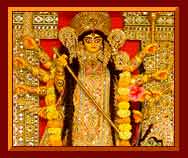 |
Durga Pujo Celebration in West Bangal |
Region: West Bengal, Bihar, Uttar Pradesh, Delhi & Madhya Pradesh.
During Durga puja or Durga Pujo (commonly called in West Bengal), the idols of Goddess Durga are worshipped for nine days in beautifully decorated 'pandaals'. It is a public festival. On the tenth day,the 'Visarjan' or immersion of idols in sea waters is performed. During this time, in various parts of India, the 'Ram-Leela' is performed. Ram-Leela is a stage inaction of Ramayana, the story of Lord Rama. Durga puja has come to be associated with a grand exhibition of cultural functions.
In towns and villages, the evenings are replete with jatra, theatre, song, music, dance programmes, sports, physical and cultural competitions etc which everyone is free to attend. Community feasts are held. The immersion ceremony (vijaya), provides an impressive finale.
Navratri Puja
During Durga puja or Durga Pujo (commonly called in West Bengal), the idols of Goddess Durga are worshipped for nine days in beautifully decorated 'pandaals'. It is a public festival. On the tenth day,the 'Visarjan' or immersion of idols in sea waters is performed. During this time, in various parts of India, the 'Ram-Leela' is performed. Ram-Leela is a stage inaction of Ramayana, the story of Lord Rama. Durga puja has come to be associated with a grand exhibition of cultural functions.
In towns and villages, the evenings are replete with jatra, theatre, song, music, dance programmes, sports, physical and cultural competitions etc which everyone is free to attend. Community feasts are held. The immersion ceremony (vijaya), provides an impressive finale.
Navratri Puja
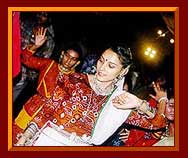 |
Famous Garba Dance from Gujarat |
Region: Gujarat, Punjab & Maharashta.
Navratri is a festival of worship, dance and music celebrated over a period of nine nights. Devotees perform the 'devi-sthaapna' in their homes wherein they invite the Goddess and perform 'pooja-path' for nine days. Gujaratis perform their traditional dances 'Garba' & 'Dandiya-Raas' during Navratri. The women-folk dance in a circle, singing 'Garbas' or traditional songs.
'Dandiya-Raas' is played with wooden sticks or 'dandiyas'. Apart from Gujrat,Garbas are performed in other states & cities like Mumbai. Young men-women wear colourful traditional dresses and play Garba with great enthusiasm.The mood of Navratri is very colourful & unique.
Kullu Dussehra
Navratri is a festival of worship, dance and music celebrated over a period of nine nights. Devotees perform the 'devi-sthaapna' in their homes wherein they invite the Goddess and perform 'pooja-path' for nine days. Gujaratis perform their traditional dances 'Garba' & 'Dandiya-Raas' during Navratri. The women-folk dance in a circle, singing 'Garbas' or traditional songs.
'Dandiya-Raas' is played with wooden sticks or 'dandiyas'. Apart from Gujrat,Garbas are performed in other states & cities like Mumbai. Young men-women wear colourful traditional dresses and play Garba with great enthusiasm.The mood of Navratri is very colourful & unique.
Kullu Dussehra
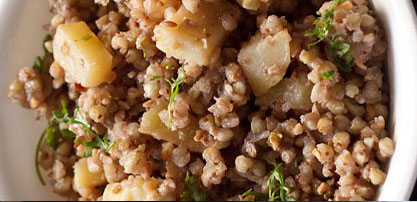 |
Celebrating Kullu Dussehra at kuulu Valley, Himachal Pradesh |
Region: Kullu Valley, Himachal Pradesh.
The annual mela or festival takes place in the Kullu Valley - also known as the Valley of the Living Gods, in North India. The festival celebrates the triumph of the God Ram over evil. The Rath Yatra of the idol of Lord Ragunath is led by the Kullu Raja and village deities, and is known as the running of the Gods. The procession starts a week of religious ceremonies, cultural activities, socializing and shopping at the huge bazaar, or market, that comprises most of the mela ground.
Dussehra at Kullu commences on the tenth day of the rising moon, i.e. on 'Vijay Dashmi' day itself and continues in seven days. The birth of Dussehra in Kullu lay in royal fads and it nourished on religious, social and economic factors and ultimately came to be well established, because of the inborn love of the hill-men for fun, frolic, displayed in community singing and dancing. Numerous stalls offer a verity of local wares. This is also the time when the International Folk Festival is celebrated.
Mysore Dussehra
The annual mela or festival takes place in the Kullu Valley - also known as the Valley of the Living Gods, in North India. The festival celebrates the triumph of the God Ram over evil. The Rath Yatra of the idol of Lord Ragunath is led by the Kullu Raja and village deities, and is known as the running of the Gods. The procession starts a week of religious ceremonies, cultural activities, socializing and shopping at the huge bazaar, or market, that comprises most of the mela ground.
Dussehra at Kullu commences on the tenth day of the rising moon, i.e. on 'Vijay Dashmi' day itself and continues in seven days. The birth of Dussehra in Kullu lay in royal fads and it nourished on religious, social and economic factors and ultimately came to be well established, because of the inborn love of the hill-men for fun, frolic, displayed in community singing and dancing. Numerous stalls offer a verity of local wares. This is also the time when the International Folk Festival is celebrated.
Mysore Dussehra
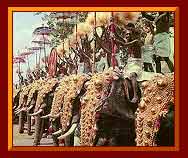 |
In Mysore Dussehra is celebrated with the march of ornamented elephants. |
Region: Mysore, Karnataka.
In Mysore, Dussehra is easily the most popular festival. It is celebrated on a grandiose scale here. Elephants are decked up with robes and jewelery and taken in processions through the streets of the city. In fact, many people visit Mysore from all over the country to watch this colorful event. There is also a floating festival in the temple tank at the foot of Chamundi Hill and a procession of chariots around the temple at the top.
The Dussehra of Mysore or Mysore Dassara as it is famously called is a 10-day long festival. On the day of Dussehra, a procession of caparisoned elephants carrying the idol of goddess Chamundi is taken through the city. The festival is celebrated in a grand style with scores of cultural performances in the great Durbar Hall of the Maharaja's Palace. On Vijaydashami, the 10th day of the festival, a colorful procession featuring caparisoned elephants winding through the gaily-decorated streets of the city, mark the occasion.
Bommai Kolu
In Mysore, Dussehra is easily the most popular festival. It is celebrated on a grandiose scale here. Elephants are decked up with robes and jewelery and taken in processions through the streets of the city. In fact, many people visit Mysore from all over the country to watch this colorful event. There is also a floating festival in the temple tank at the foot of Chamundi Hill and a procession of chariots around the temple at the top.
The Dussehra of Mysore or Mysore Dassara as it is famously called is a 10-day long festival. On the day of Dussehra, a procession of caparisoned elephants carrying the idol of goddess Chamundi is taken through the city. The festival is celebrated in a grand style with scores of cultural performances in the great Durbar Hall of the Maharaja's Palace. On Vijaydashami, the 10th day of the festival, a colorful procession featuring caparisoned elephants winding through the gaily-decorated streets of the city, mark the occasion.
Bommai Kolu
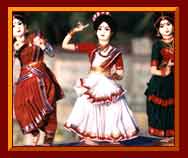 |
Dalls displayed in Bommai Kolu |
Region: Tamil Nadu, Karnataka & Andhra Pradesh.
Bommai Kolu is traditionally a women's festival that Tamilians celebrate during Dasshera. Every year, a series of steps is set up and kolu bommai or dolls are displayed. These dolls typically depict gods or village scenes and weddings. A kolu can be as simple or as elaborate as one likes. The woman of the house invites other women to come inspect the kolu, eat a few snacks, exchange a little gossip and go home with a couple of small goodies.
During this time, the girls and women make rounds from house to house during those nine days of Navrathri. Sundal is a delicious confection made from bean sprouts and coconut that is traditionally served at kolu. Women set up decorated planks in a corner and place on it all the dolls in the house. This beautiful clay figurines of gods and goddesses are worshipped during Navaratri, viewing art as Divinity. Women traditionally exchange gifts of coconuts, clothes and sweets.
Ayudha Puja
Bommai Kolu is traditionally a women's festival that Tamilians celebrate during Dasshera. Every year, a series of steps is set up and kolu bommai or dolls are displayed. These dolls typically depict gods or village scenes and weddings. A kolu can be as simple or as elaborate as one likes. The woman of the house invites other women to come inspect the kolu, eat a few snacks, exchange a little gossip and go home with a couple of small goodies.
During this time, the girls and women make rounds from house to house during those nine days of Navrathri. Sundal is a delicious confection made from bean sprouts and coconut that is traditionally served at kolu. Women set up decorated planks in a corner and place on it all the dolls in the house. This beautiful clay figurines of gods and goddesses are worshipped during Navaratri, viewing art as Divinity. Women traditionally exchange gifts of coconuts, clothes and sweets.
Ayudha Puja
 |
Idol of Sri Ram & devi Sita |
Region: Tamil Nadu, Kerala, Karnataka & Andhra Pradesh
The ninth day is also the day of the Ayudha Puja. After the slaying of Mahishasura and other demons by Chamundeswari, there was no more use for her weapons. So the weapons were kept aside and worshipped. This Ayudha puja is being celebrated since ancient times. The importance of Ayudha Puja on this occasion may also be due to the fact that on the Vijayadasami day, Arjuna took back his weapons which he had hidden in a Vani tree in order to lead a life in disguise for the promised period of exile. It is believed that one who begins or renovates his learning to work on the Vijayadasami day will secure a grand success as Arjuna did in Kurukshetra war.
The Ayudha Puja is a worship of whatever implements one may use in one's livelihood. On the preceding evening, it is traditional to place these implements on an altar to the Divine. If one can make a conscious effort to see the divine in the tools and objects one uses each day, it will help one to see one's work as an offering to God. It will also help one to maintain constant remembrance of the divine. In India it is customary for one to prostrate before the tools one will use before starting one's work each day; this is an expression of gratitude to God for helping one to fulfil one's duties.
Vidyaramba
The ninth day is also the day of the Ayudha Puja. After the slaying of Mahishasura and other demons by Chamundeswari, there was no more use for her weapons. So the weapons were kept aside and worshipped. This Ayudha puja is being celebrated since ancient times. The importance of Ayudha Puja on this occasion may also be due to the fact that on the Vijayadasami day, Arjuna took back his weapons which he had hidden in a Vani tree in order to lead a life in disguise for the promised period of exile. It is believed that one who begins or renovates his learning to work on the Vijayadasami day will secure a grand success as Arjuna did in Kurukshetra war.
The Ayudha Puja is a worship of whatever implements one may use in one's livelihood. On the preceding evening, it is traditional to place these implements on an altar to the Divine. If one can make a conscious effort to see the divine in the tools and objects one uses each day, it will help one to see one's work as an offering to God. It will also help one to maintain constant remembrance of the divine. In India it is customary for one to prostrate before the tools one will use before starting one's work each day; this is an expression of gratitude to God for helping one to fulfil one's duties.
Vidyaramba
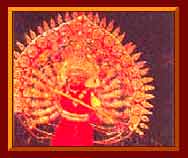 |
Vidyaramba |
Region: Tamil Nadu, Karnataka & Kerala.
The tenth day or Vijayadasami is also the day of Vidyaramba or beginning of study when children usually begin to learn the alphabets. On the Vijayadasami day after a Puja in the morning, the Books and implements are removed from the room and this ceremony is called 'Puja Eduppu'. The time for the break up of the puja marks the beginning of learning and work. Learning and work commence at this auspicious moment.
Literates, in general write the alphabets on sand and read a few sentences from sacred books. Similarly the craftsmen and other skilled workers do some work using their implements. At this auspicious moment the children for the first time are given instructions to write the first few alphabets on rice or sand. They are thus initiated into the world of knowledge. This is called 'Ezhuthinu Iruthu' and according to custom only after this ceremony child becomes entitled to write or read.
Saraswati Puja
The tenth day or Vijayadasami is also the day of Vidyaramba or beginning of study when children usually begin to learn the alphabets. On the Vijayadasami day after a Puja in the morning, the Books and implements are removed from the room and this ceremony is called 'Puja Eduppu'. The time for the break up of the puja marks the beginning of learning and work. Learning and work commence at this auspicious moment.
Literates, in general write the alphabets on sand and read a few sentences from sacred books. Similarly the craftsmen and other skilled workers do some work using their implements. At this auspicious moment the children for the first time are given instructions to write the first few alphabets on rice or sand. They are thus initiated into the world of knowledge. This is called 'Ezhuthinu Iruthu' and according to custom only after this ceremony child becomes entitled to write or read.
Saraswati Puja
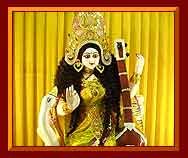 |
Goddess Saraswathi |
Region: Kerala, Karanataka & Tamil Nadu.
The Goddess Saraswathi is worshipped as the Goddess of Learning, the deity of Gayathri, the fountain of fine arts and science, and the symbol of supreme vedantic knowledge. On the Durgashtami day ,a ceremony called Poojavaipu is performed in the evening in Kerala. In a village, generally, it is done only in certain households, in temples and also sometimes in the village schools. The Brahmin houses and the houses which enjoy reputation for learning, mainly take the lead in celebrating the festival. The members of other houses in the village attend the ceremony performed in these houses or institutions.
In a well-decorated room, books and grandhas (holy books) are tastefully arranged with a picture or an image of Goddess Saraswathi in front. In certain poaches weapons and implements are kept by the side of books and garandhas. Then a Puja is performed to Saraswathi during which fruits, beaten rice, roasted paddy (malar), jaggery etc, are offered to Her. These offerings are distributed among those present when the Puja is over.
Just before the Pujavaipu, all studies and work which mainly require skill, are suspended. The following day is known as Mahanavami and it is totally devoted to the worship of Saraswathi. Pooja is performed both in the morning and in the evening. Many more items such as rice, payasam, thirali, etc are also offered to Devi.
The ten-day Saraswati festival, also known as Dussehra or Navaratri, is held September-October. It's celebrated throughout India but takes on special significance in Kerala. Young children are taken to the temples and, before an image of a goddess-celebrated in Kerala as Saraswati, the goddess of wisdom and learning-they are introduced to the letters of the alphabet.
Simollanghan
The Goddess Saraswathi is worshipped as the Goddess of Learning, the deity of Gayathri, the fountain of fine arts and science, and the symbol of supreme vedantic knowledge. On the Durgashtami day ,a ceremony called Poojavaipu is performed in the evening in Kerala. In a village, generally, it is done only in certain households, in temples and also sometimes in the village schools. The Brahmin houses and the houses which enjoy reputation for learning, mainly take the lead in celebrating the festival. The members of other houses in the village attend the ceremony performed in these houses or institutions.
In a well-decorated room, books and grandhas (holy books) are tastefully arranged with a picture or an image of Goddess Saraswathi in front. In certain poaches weapons and implements are kept by the side of books and garandhas. Then a Puja is performed to Saraswathi during which fruits, beaten rice, roasted paddy (malar), jaggery etc, are offered to Her. These offerings are distributed among those present when the Puja is over.
Just before the Pujavaipu, all studies and work which mainly require skill, are suspended. The following day is known as Mahanavami and it is totally devoted to the worship of Saraswathi. Pooja is performed both in the morning and in the evening. Many more items such as rice, payasam, thirali, etc are also offered to Devi.
The ten-day Saraswati festival, also known as Dussehra or Navaratri, is held September-October. It's celebrated throughout India but takes on special significance in Kerala. Young children are taken to the temples and, before an image of a goddess-celebrated in Kerala as Saraswati, the goddess of wisdom and learning-they are introduced to the letters of the alphabet.
Simollanghan
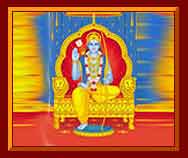 |
Simollanghan |
Region: Maharashtra
In ancient times kings used the feast of Dasara to cross the frontier and fight against their neighboring kingdoms. This border crossing is known as "Simollanghan". Thus Dasara also marks the beginning of the war season.
This was also the day to worship the weapons. According to legend, Pandav went to dwell in the forest. On the way he hid his weapons in the hole of a "shami" tree. After one year he returned from the forest and on Dussehra day he took again his weapons and worshipped the shami tree and the weapons. Hence the custom of worshipping weapons on this feast.
People decorate the entrances of their homes with torans, flower studded strings, and worship the tools of trade, vehicles, machinery, weapons and even books. As the evening falls, the villagers cross the border, and worship the Shami tree. The leaves of the Apta tree are collected and exchanged among friends and relatives as gold.
The Story/ Legends of Durga Puja
In ancient times kings used the feast of Dasara to cross the frontier and fight against their neighboring kingdoms. This border crossing is known as "Simollanghan". Thus Dasara also marks the beginning of the war season.
This was also the day to worship the weapons. According to legend, Pandav went to dwell in the forest. On the way he hid his weapons in the hole of a "shami" tree. After one year he returned from the forest and on Dussehra day he took again his weapons and worshipped the shami tree and the weapons. Hence the custom of worshipping weapons on this feast.
People decorate the entrances of their homes with torans, flower studded strings, and worship the tools of trade, vehicles, machinery, weapons and even books. As the evening falls, the villagers cross the border, and worship the Shami tree. The leaves of the Apta tree are collected and exchanged among friends and relatives as gold.
The Story/ Legends of Durga Puja
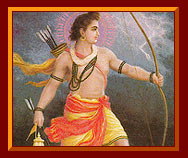 |
Lord Rama, invoked the blessings of Durga to kill Ravana. |
Goddess Durga represents a united front of all Divine forces against the negative forces of evil and wickedness. The gods in heaven decided to create an all-powerful being to kill the demon king Mahishasur who was ready to attack them. At that very moment a stream of lightning dazzled forth from the mouths of Brahma, Vishnu and Mahesh and it turned into a beautiful, magnificent woman with ten hands. Then all the gods furnished her with their special weapons. The image of Durga, the Eternal Mother destroying the demon, Mahishasur is symbolic of the final confrontation of the spiritual urge of man with his baser passions.
Pandavas
As per our great epic Mahabharat, Pandavas after wandering in the forest for 12 years, hung their weapons on a Shami tree before entering the court of king Virat to spend the last one year in disguise. After the completion of that year on Vijayadashmi the day of Dassera they brought down the weapons from the Shami tree and declared their true identity. Since that day the exchange of Shami leaves on Dassera day became symbols of good, will and victory.
Lord Rama
This festival has immense mythological significance. As per Ramayan, Ram did "chandi-puja and invoked the blessings of Durga to kill Ravana, the ten-headed king of Lanka who had abducted Seeta and had charmed life. Durga divulged the secret to Ram how he could kill Ravana. Then after vanquishing him, Ram with Seeta and Laxman returned victorious to his kingdom of Ayodhya on Diwali day.
Kautsa
Kautsa, the young son of Devdatt, insisted on his guru Varatantu to accept "gurudakshina", after finishing his education. After lots of persistence his Guru, finally asked for 14 crore gold coins, one crore for each of the 14 sciences he taught Kautsa. Kautsa went to king Raghuraj, who was known for his genorisity and was an ancestor of Rama. But just at that time he had emptied all his coffers on the Brahmins, after performing the Vishvajit sacrifice. So, the king went to Lord Indra and asked for the gold coins. Indra summoned Kuber, the god of wealth. Indra told Kuber, "Make a rain of gold coins fall on the "shanu" and "apati" trees round Raghuraja's city of Ayodhya." The rain of coins began to fall. The king Raghu gave all the coins to Kautsa, who gave 14 crores gold coins to his guru. The remaining coins were lavishly distributed to the people of Ayodhya city. This happened on the day of Dussehra. In remembrance of this event the custom is kept of looting the leaves of the "apati" trees and people present each other these leaves as "sone" (gold).

No comments:
Post a Comment